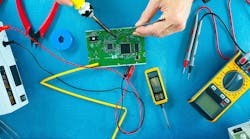Role of Electronic Test & Measurement Equipment in Defense and Aerospace
The defense and aerospace industry is one of the most vast and expansive industries in operation the world over. Deloitte surmises that as of 2013, the revenue generated within this industry had grown to the absolutely astounding figure of $706 billion. And that’s not all: The increase was tracked at $21 billion in the last five years, making it the industry with the second-largest growth in that time period stretching from 2009 to 2013. And while there was a perceptible 2.5% drop in revenue for the top 20 U.S. defense contractors, there hasn’t been a proportionate decline in the employment numbers in the industry, as the U.S. aerospace and defense sector saw a drop of only 1.3% in employment numbers. Globally, over 2 million people work in this industry, and despite the fact that the numbers have taken a slight slump in context of the U.S. market in particular, U.S.-based aerospace and defense companies still account for a staggering 59% of the total global aerospace and defense revenues. Overall, 2013 was a good year for U.S.-based defense and aerospace companies, too, as they saw a profit increase of 11.6% collectively, compared to their European counterparts who saw a 3.6% decline instead.
According to a more recent report published by Deloitte, the U.S. is still the biggest spender on defense globally. Of the global 2013 annual spend of $1.731 trillion, the U.S. accounts for 39% or $675.1 billion. To put things into perspective, China, Russia, France, Japan, and the UK all collectively take second spot with a joined contribution of just 22%.
Equipment Testing in Defense and Aerospace
The aerospace and defense industry is a massive, multibillion-dollar empire then, particularly here in the U.S. And when there’s that much investment on the line, the electronics and technology used in this industry needs to be running at 100% efficiency level to make sure that the equipment doesn’t malfunction and get damaged or provide lower utility than it ideally should. This is where electronic test equipment comes to the fore. What’s fundamental here is that the electronics used on, say, a fighter jet or a combat vehicle are a lot more complex and advanced than those you would find on their civilian counterparts, and the loss of this equipment as a result wouldn’t just account for millions and millions of tax dollars, but would also carry with it the heavy weight of potential for loss of the life of brave members of the U.S. armed forces as result of electronic failure.
This is why the test equipment industry has grown in prominence and developed hand-in-hand with the development of the defense and aerospace industry itself, and this is why the test equipment industry is considered such a vital cog of a nation’s defense structure as well. Technicians and engineers are highly respected and highly prized members of all the various divisions of the armed forces, and it is because the responsibility they carry—making sure all the electronic equipment employed by the armed forces is functioning at the highest possible level, is crucial.
The Importance of Calibration
One of the most important aspects of testing equipment though is calibration. If the testing equipment itself is malfunctioning, then the results it obtains will also be inaccurate, and could lead to a whole host of complications. Because of this, a greater focus is being cast on the calibration side of the testing industry, with military operations also focusing on this particular aspect of the testing industry. In particular, the requirement of ISO/IEC 17025:2005 certification on all testing equipment has become an absolute must. So what is this certification? One can refer to TRS-RenTelco, who is providing the answer on the ISO/IEC 17025:2005 certification. One of the quotes on the testing equipment website says, “ISO/IEC 17025:2005 is becoming the main standard used by testing and calibration laboratories. There are many commonalities with the ISO 9001:2008 standard, but ISO 17025 adds the concept of competence to the equation.”
Testing is carried out regularly and diligently, and it is also ensured that the testing equipment is firing on all cylinders, and is certified to make sure the results it obtains are 100% accurate. ISO/IEC 17025:2005 is the highest stature of certification in the U.S. market, and is considered the standard for the defense and aerospace industry as well.
Lisa Clark is a product and test engineer by profession from Madison, Wis., and has been working as a freelance product & test engineer. She keeps herself up-to-date with the advancements and challenges in the test & measurement equipment industry. She also has a keen interest in writing and reading articles related to electronic test, measurement and monitoring equipment.
